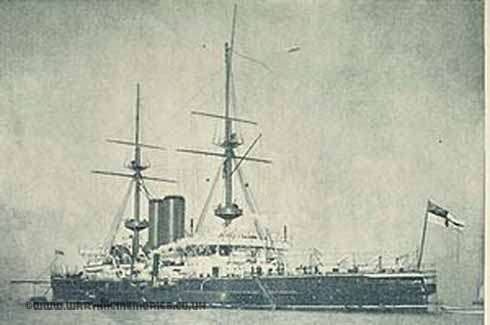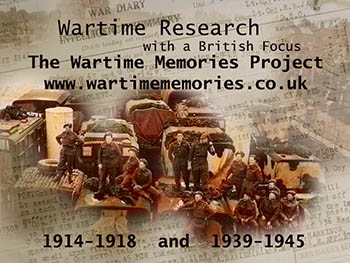1st July 1914 HMS Glory 
HMS Glory
HMS Glory (1899 - 1921) was built by laird Brothers, Birkenhead, laid down on 1st December 1897, launched on 11th May 1899 Commissioned in October 1900 and Scrapped in 1922.
a member of the Canopus class of pre-dreadnought battleships designed by Sir William White for use in the Far East and entered service between 1899 and 1902.
The lead ship was HMS Albion, which was followed by Canopus, Glory, Goliath, Ocean and Vengeance.
The class had primary armament consisting of four 12 inch (305 mm) 35 calibre long guns and six 6-inch (152 mm) 40 calibre long guns.
The introduction of HMS Dreadnought in 1906 rendered the class, and all other pre-dreadnought battleships, obsolete only a few years after the last-of-class entered service in 1902.
The class saw service across the globe: in home waters, on the China Station, in the Mediterranean Fleet, in the Atlantic, in Africa, at Archangel, and in the Mediterranean where HMS Goliath and HMS Ocean were sunk during the Dardanelles campaign. The four surviving ships were reduced to subsidiary duties late in World War I and were scrapped in the early 1920s.
List of Ships in Canopus Class
- HMS Albion
- HMS Canopus
- HMS Glory
- HMS Goliath
- HMS Ocean
- HMS Vengeance
General characteristics
The Canopus-class battleships were designed for use in the Far East to counter the expanding Japanese navy and were required to be able to pass through the Suez Canal. They were designed to be smaller, lighter and faster than their predecessors, the Majestic-class battleships, although at 421.5 ft (128.5 m) they were slightly longer.
Armour
The armoured belt, situated at the waterline of the vessel, was 6 inches (152 mm) thick.
To save weight the Canopus class carried less armour than the Majestics, but a change from Harvey armour in the Majestics to Krupp armour in the Canopus class meant that the protective capability of the armour was maintained.[nb 1] Part of their armour scheme included the use of a special 1 in (25 mm) armoured deck over the armour belt to defend against plunging fire by the howitzers that France had reportedly planned to install on its ships, although this report proved to be false.
Armament
Like the Majestics, the Canopus class ships had four 12-inch (305 mm) guns mounted in twin turrets fore and aft. The final ship, Vengeance, had an improved mounting that allowed loading at any elevation; her turret gunhouses differed from those of her sisters in being Krupp-armoured and flat-sided (Krupp armour plates were difficult to form into curves). The ships mounted twelve 6-inch (152 mm) guns[nb 2] in armoured casemates as well having some smaller guns and four submerged 18-inch (450 mm) torpedo tubes.
Propulsion
The Canopuses were the first British battleships with water-tube boilers, which generated more power for their weight when compared with the cylindrical boilers used in previous ships. The new boilers led to the adoption of fore-and-aft funnels, rather than the side-by-side funnel arrangement used in many previous British battleships. The Canopus-class ships proved to be good steamers, consuming 10 short tons (9.1 t) of coal per hour at full speed.[7] At 18 kn (33 km/h; 21 mph) they were fast for battleships of their time, a full 2 kn (2.3 mph) faster than the Majestics. The Canopuses were able to reach 4,500 mi (7,200 km) at 10 kn (19 km/h; 12 mph) with a full load of coal.
First World War Service
When World War I broke out in August 1914, Glory was assigned to the 8th Battle Squadron, Channel Fleet, based at Devonport, but she was detached on 5 August 1914 to serve at Halifax, Nova Scotia, Canada, as guard ship and to support the North America and West Indies Station cruiser squadron, serving as flagship of the station. She escorted a Canadian troop convoy in October 1914.
Glory transferred to the Mediterranean in May 1915 to participate in Dardanelles campaign, arriving at the Dardanelles in June 1915. At the end of 1915 she left this duty and joined the Suez Canal Patrol in the Mediterranean on 4 January 1916. In April 1916, she returned to the United Kingdom and began a refit at Portsmouth that lasted until July 1916.
Glory was recommissioned on 1 August 1916 to serve as Flagship for Rear Admiral Kemp, British North Russia Squadron. In this duty, she was based at Archangel to protect supplies that arrived there for the Russian Army.
Decommissioning and disposal
In September 1919, Glory returned to the United Kingdom. She was paid off into care and maintenance on 1 November 1919 at Sheerness.[5] She was renamed HMS Crescent in April 1920 and transferred to Rosyth on 1 May 1920 to serve as a harbor depot ship.
Crescent was paid off and was placed on the disposal list on 17 September 1921. She was sold for scrapping on 19 December 1922.
John Doran
If you can provide any additional information, please add it here.





